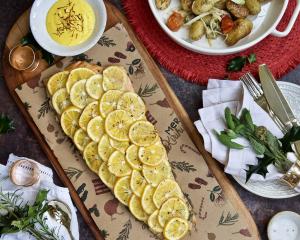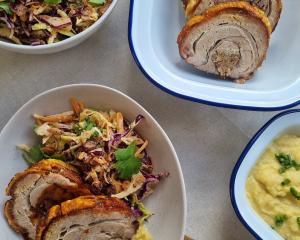Whether they are shiny dark green, dark with striped paler ribs, or yellow, courgettes are a sure sign of summer.
They originated in the Mediterranean - the French and English call them courgettes and the Italians, Americans and Australians call them zucchini - and have only become common outside the region in the past 30 years or so. That's probably why, according to Alan Davidson in The Oxford Companion to Food, there is no true English name for them.
Also grouped as summer squash, you can sometimes find flying-saucershaped scallopini, tennis ball-sized ones, and some that have a bit of a hook at one end.
The yellow and green ones taste much the same, but I like the flavour of the deeply ribbed ones, although they can be hard to find unless you grow them yourself.
Courgettes are easy to grow and this time of the year they fruit copiously. Miss one of the shiny little fruit hidden under the luxuriant leaves and while your back is turned you are likely to find it's become a full-grown, watery marrow.
Courgettes have the best flavour when they are small, before the water swells them and dilutes the flavour. At about a finger length they are delicious raw, sliced lengthways and served with a dip or grated and added to a salad.
A major advantage of growing them yourself is you also get the golden flowers. Too fragile for the transport and the long shelf-life required of supermarket vegetables, they can sometimes be found at farmers' markets. They can be eaten raw if they are very fresh, sliced finely in salads, but are delicious sauteed or stuffed and baked or fried.
Courgettes too can be stuffed - either cut in half lengthways and scoop out some of the flesh or, if you have a traditional coring tool, hollow out the centre. Stuffings can be made with feta, ricotta or goat's cheese, cooked rice with tomatoes and herbs, or minced meat cooked with herbs and spices.
Select courgettes that are as fresh as possible, firm and with few blemishes. Store for only a few days in the vegetable drawer of the fridge. The skin, especially of the dark green and yellow ones, is fragile and doesn't need to be peeled. Rinse, cut off the hard stem and slice either into rounds, batons or lengthwise. If you want really thin, ribbon slices, use a potato peeler.
One of the problems - or advantages depending on what you want to do with them - is that they exude water when cooked. This is fine when you want extra juice, as in a ratatouille or vegetable stew, but annoying if you want to fry them. Some people recommend slicing or grating them, sprinkling them with salt to draw the water out and leaving for 20 or 30 minutes, then squeezing them. I can't usually be bothered with that, and just cook the extra juice off.
Courgettes are mildly flavoured and go well with garlic, most green herbs, cheeses such as Parmesan or feta, eggplant, tomatoes, eggs, pine nuts, capers, anchovies, lemons, onions, walnuts, sunflower seeds, wine vinegar and yoghurt.
My favourite way to cook them is thinly sliced with a tablespoon or so of olive or avocado oil and another of water in a tightly-lidded pot for 3-5min. Finely chopped garlic is a good addition, as are a handful of pine nuts or sunflower seeds. Season with salt and freshly ground black pepper and, if you like, a little mint, basil, oregano, chives or parsley. A sprinkling of wine vinegar in the Neapolitan fashion, or lemon juice, can give them a lift.
Serve them hot, warm or cold as a side dish, slather them on toasted ciabatta for a bruschetta topping, toss them with freshly cooked pasta and sprinkle with freshly grated parmesan.
Courgettes are also an ideal vegetable to barbecue or griddle. Slice lengthways, brush with oil and barbecue until streaked with brown from the griddle. Serve hot or warm, toss with extra virgin olive or avocado oil and lemon juice or balsamic vinegar.
A fresh or cooked tomato sauce is a good addition, and in Arab countries courgettes are served with plain, unsweetened yoghurt, drained and seasoned with finely chopped mint and salt.
In the Middle East, they also make a spiced courgette puree for serving as a spread or dip, or as a salad. Several recipes call for cooking the courgettes in water, then draining well, but I prefer to cook in a little oil as above. Mash them with garlic, lemon juice, cumin or caraway and extra oil if you are feeling extravagant.
Garnish with olives or crumbled feta and perhaps harissa, a Moroccan hot chilli paste.
Another version mashes them with garlic, lots of dried mint and freshly ground black pepper, wine vinegar and olive oil, and garnishes it with capers.
Ratatouille is a wonderful summer dish. Basically a stew of eggplants, courgettes, tomatoes and peppers, usually with garlic and onion and sometimes seasoned with capers, anchovies, herbs or olives, it can be eaten hot or cold. In fact, I think it often tastes better the following day.
Soften a chopped onion in olive oil, chop and add the other vegetables, and simmer until they are soft, Season with salt, pepper and vinegar.
Courgette flan recipe
Courgettes go well with eggs - frittata and fritters are good ways to use them - but I liked the idea of this Provencal flan.
It's like a quiche without the pastry. It is based on one of Claudia Roden's recipes and she serves it with a tomato and caper sauce, but other books use the same mixture topped with cheese and breadcrumbs to make a gratin.
1 onion, finely chopped 1-2 Tbsp olive oil 4 large eggs 1 /2 cup milk 4-5 courgettes, finely sliced salt, freshly ground pepper and nutmeg to season.
Soften the onion slowly in oil until golden. Beat the eggs lightly, add milk, courgettes, seasoning and onion. Pour into an oiled flan mould or baking dish and bake at 180degC for about an hour until set in the middle and slightly puffed and brown.
Serve hot, warm or cold with a fresh tomato sauce: cook 1-2 cloves chopped garlic and 5-6 chopped tomatoes slowly in a little olive oil with a pinch of sugar and salt and pepper until reduced. Add a tablespoon or two of capers and the same of chopped olives.











